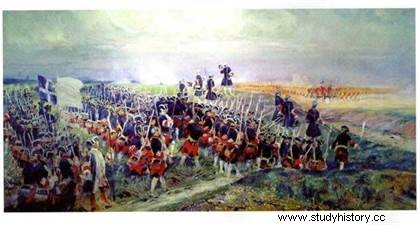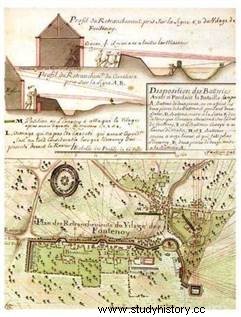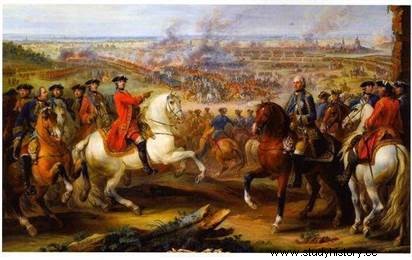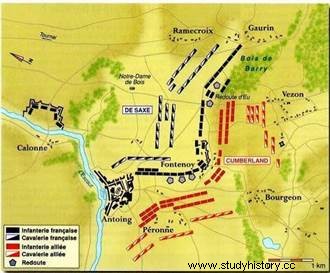 Among the great victories between the House of Bourbons and that of Habsburg and in the confrontation between the French and the English, the Battle of Fontenoy is the most famous, which became popular thanks to this phrase “English gentlemen, shoot first!” ". On May 6, 1745, King Louis XV left Versailles with the Dauphin and took the direction of Tournai to witness the capitulation of the city, accompanied by a procession of 1000 people stretching over more than two kms...he stopped in the small village of Fontenoy…
Among the great victories between the House of Bourbons and that of Habsburg and in the confrontation between the French and the English, the Battle of Fontenoy is the most famous, which became popular thanks to this phrase “English gentlemen, shoot first!” ". On May 6, 1745, King Louis XV left Versailles with the Dauphin and took the direction of Tournai to witness the capitulation of the city, accompanied by a procession of 1000 people stretching over more than two kms...he stopped in the small village of Fontenoy…
The Tournai region, scene of the Battle of Fontenoy
Tournai, crossed by the Scheldt, is a gateway to the Flemish plain and the cities of Ghent and Antwerp. Capital of the Franks in the 5th century, then attached to the county of Flanders, it became French under Philippe Le Bel, then conquered by Charles Quint, taken by Louis XIV, ceded to Austria then… finally taken back during this campaign of 1745!
Louis XV was at war on all sides:in 1740 War of the Austrian Succession; in March 1744 war against the King of England; in April 1744 declaration of war on the Queen of Hungary. The battlefield will be in the North, the king entrusts the army to the Marshal of Saxe:this is how he will first conquer Tournai. The city is well equipped with hospitals and the infrastructure is sufficient to feed and house the soldiers. The battle plan was drawn up in December 1744 to really begin in the spring of 1745:concentrate the army in the north, make a diversion towards Mons and Charleroi and suddenly leave towards Tournai to surprise the Dutch.
The Marshal of Saxe settles
On April 6, 1745, Maurice de Saxe was in Lille, commanding an army of 100,000 men. Meanwhile, the Duke of Cumberland landed in Ostend at the head of 55,000 men made up of Hanoverians, English and Dutch. Cumberland spies on the French, and finds that the army has concentrated between Armentières and Maubeuge, deducing that the attack will be towards Mons and Charleroi. The Allies then closed the locks of Oudenaarde, towards Ghent; the right bank of the Scheldt is flooded as far as Condé sur Escaut over about sixty km.
 On April 25, 1745, 6,000 French people showed up in front of Tournai, creating quite a surprise. The next day, the Marshal of Saxe begins the siege of the city with his 60,000 men.
On April 25, 1745, 6,000 French people showed up in front of Tournai, creating quite a surprise. The next day, the Marshal of Saxe begins the siege of the city with his 60,000 men.
On April 28, 1745, the Duke of Cumberland decided to march towards Tournai:he wanted to take the French from the rear, push them towards the city, and thus defeat them once 'they will be caught in the crossfire… But the Marshal of Saxe had already thought about it and organized himself accordingly! Cumberland has a greater speed of action… except that he is badly obeyed by his subordinates jealous of his rank (duke and commander at the age of twenty-five!)… his army does not go into action until the 30 to Brussels, taking nine days to reach Tournai which is only seventy km away...a sufficient time for Maurice of Saxony to organize himself.
The Marshal decides that the fight will take place in the plain of Fontenoy, out of range of the guns of Tournai. The place is backed by the Scheldt, on a square of a good kilometer and a half on a side, attackable only on two fronts, the village being an articulation between these two fronts, with the wood of Barri to the north and to the south the Scheldt; the slightly sloping terrain, the enemy's march being uphill, thus favoring the defense.
At the same time, the Marshal reorganized his army:20,000 men for the siege; 40,000 men directed towards Fontenoy. He had abattis placed in the wood of Barri, fortified the village, built redoubts to the north to cover his army and to the south to close the space between the villages of Fontenoy and Antoing. He set up his infantry and his cavalry on the left towards the Bois de Barri and on the right on the Scheldt.
He entrusted the fortification of the village to M. de La Vauguyon, who had eight guns:two battalions and two batteries were placed in the redoubt in the Bois de Barri and the bulk of the he infantry was established on four lines between Fontenoy and the redoubts in the woods (four hundred and thirty workers from the Dauphin and Beauvaisis regiments worked, the entrenchments were completed after twenty hours). Behind is "the cavalry in two lines", "The Maison du Roy, the Gendarmerie and eight Carabinieri squadrons are in reserve behind the Cavalry".
The Battle of Fontenoy
On May 10, 1745, everything was in place, the French were waiting for the 55,000 men from Cumberland. The "enemies settled in the village of Vezon, opposite Fontenoy", on the right on the Bois de Barri and on the left on the Scheldt. The Dutch attack the village of Bourgeon:the few hundred French entrenched, abandon the position. During the night and taking advantage of the fog, the Marshal of Saxe sent a reinforcement of six artillery pieces to Fontenoy.
 On May 11, 1745 at 4 a.m., the King and the Dauphin were hard at work and "at one hour of daylight, the enemies advanced in good order towards the army of the King…”
On May 11, 1745 at 4 a.m., the King and the Dauphin were hard at work and "at one hour of daylight, the enemies advanced in good order towards the army of the King…”
Shortly before 6 a.m., the allies bombarded the positions and the French lines returned fire, the Duke of Gramont lost his life.
The Dutch resume their attack between Fontenoy and Antoing. At 9 a.m., they are within gunshot of Fontenoy. For half an hour, the fire is fed. They charge and lose many soldiers. The Maréchal de Saxe protects the rear of the village with the brigades of the Royal and the Crown.
The 8,000 Anglo-Hanoverians advance and suffer losses... in vain:"the English attacked Fontenoy three times and the Dutch tried twice to take Antoing". Cumberland reflected, modified his plans and attempted a maneuver in a small space between the redoubts of Barri Wood and Fontenoy. He reorganized his infantry "into two thick lines, with a third in reserve", his cavalry forming a fourth column. The whole thus represents a compact parade of 15,000 men.
The armies face each other...this is perhaps where the famous phrase would have been pronounced "Misters English, shoot first". In fact, the rules in the infantry at that time were such that whoever didn't shoot first had a certain advantage afterwards!
The English wreaked havoc, cut the first two French lines, advanced straight ahead, slowly but surely… The French, all corps confused, attacked; they make them suffer losses…but the English are still advancing, without slowing down the march….the French Guards and the Swiss Guards disperse…the English column is ready to take Fontenoy from the rear…the Marshal of Saxe sends his cavalry back to the charge …the English column suffers but continues its advance…
 Around 1 p.m., the French were in a critical phase...several people from the king's entourage urged him to take refuge on the other side of the Scheldt…impossible:it would be a defeat! Jubé recounts “this prince showed, in this critical circumstance, a great deal of confidence and coolness; and his countenance contributed to reviving the courage of the troops…a few cannonballs having come to waste on the height where he was placed, Louis XV said with a smile “Let them be sent back to the enemies, I don’t want to have anything of theirs!” .
Around 1 p.m., the French were in a critical phase...several people from the king's entourage urged him to take refuge on the other side of the Scheldt…impossible:it would be a defeat! Jubé recounts “this prince showed, in this critical circumstance, a great deal of confidence and coolness; and his countenance contributed to reviving the courage of the troops…a few cannonballs having come to waste on the height where he was placed, Louis XV said with a smile “Let them be sent back to the enemies, I don’t want to have anything of theirs!” .
Maréchal de Saxe then decided to commit all his resources, including the Maison du Roi, to attack the column from the front and on both flanks, "the horse grenadiers gave the first saber thrusts, the French guards the first bayonet thrusts…Monseigneur the Dauphin put his sword in his hand, wanted to rally the troops who had folded and charge the enemy…”.
Result “the column stops, hesitates, breaks up; in a moment, this English column which could number 8 to 10,000 men is annihilated”. It is 2 o'clock in the afternoon on May 11, 1745...Cumberland retreats trying to save what can be saved; the Marshal of Saxe sends 3,000 men in pursuit "just in case"...and satisfied with this victory, Louis XV retires around 7 p.m.!
Victory goes to …
French losses can be estimated at between 7000 and 7500 men; the English, Hanoverians and Dutch lost between 13,000 and 15,000 soldiers.
Victory is certainly won for France, but opinions differ. According to Louis XV, it belongs to the Marshal of Saxe; for General Jubé, it is obtained by a means that Voltaire claims to have been suggested by the Duc de Richelieu; as for JP Bois, it is indisputably the work of Maurice de Saxe "this battle was enough to make the Marshal of Saxe one of the greatest military talents".
Bibliography
- Colonel Frédéric Guelton, Director of Research and Head of the Department of Studies and Research of the Army Historical Service, historian. Article “the Battle of Fontenoy” in the review “Château de Versailles de l’Ancien Régime à nos jours”
- J.P. Bois – “Fontenoy 1745, Louis XV, arbiter of Europe” 1996
- Of battles and men:Fontenoy, by Denis Gandilhon. History &Collections, 2008.
